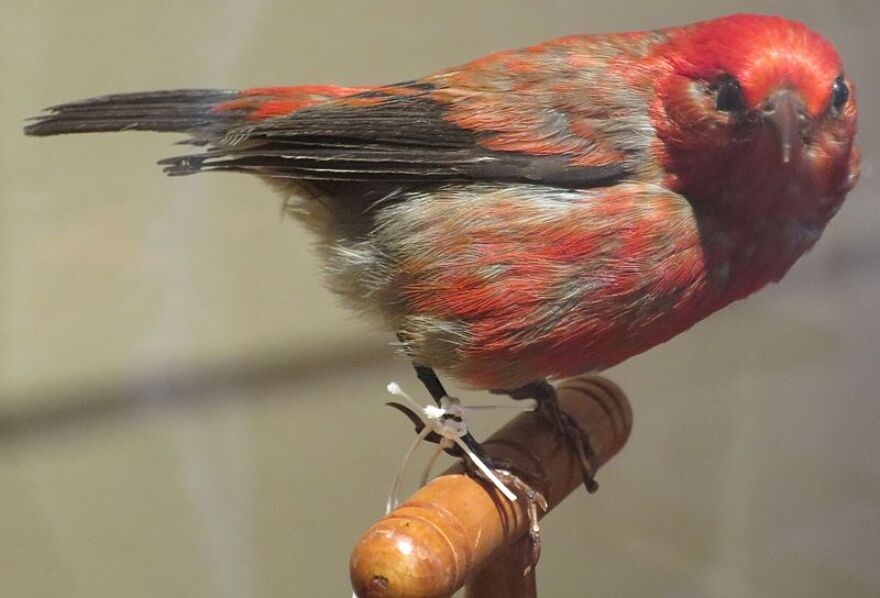
David Kuhn has spent over thirty years as a wildlife guide. As part of his own process learning Hawai‘i’s forest birds, Kuhn began recording them in the mid ‘90’s. His audio library now encompasses birds, bats, crickets, whales, waters, and, importantly, the mixed sounds of forest biophanies that are rapidly disappearing. HPR’s Noe Tanigawa visited him in K?ke‘e on Kaua‘i.
“If you close your eyes, would you really feel like you’re there? That’s my goal.”
David Kuhn is a wildlife guide and sound recordist. He works from his studio here in Kokee, but has recorded in the most remote environments in Hawai‘I, on the slopes of Mauna Kea , in Hanaw? East Maui, and Alaka‘i swamp on Kaua‘i. Kuhn's recordings are available through his website, SoundsHawaiian.
Hawai‘i’s native birds are an amazing story. Kuhn says probably twenty million years ago, a breeding pair at least was blown to the Hawaiian archipelago, found a niche and settled in. That’s pretty unlikely, in fact, rare. It may have happened as few as five times.
Kuhn says one introduction brought a red honey creeper ancestor, another, little green honey creepers, Thrushes came too, making three from North America. The honey eaters also came, but from South East Asia. Curiously, the ‘elepaio, a flycatcher is here from the South Pacific. How it got here is a mystery, since we only know storms that come from the north, the east, or, like hurricanes, from the southeast.

As we drove deeper into the park, we could see k?hili ginger is spreading in K?ke‘e. Kuhn says there are still good listening places in K?ke‘e for the most common birds, ‘apapane, ‘amakihi, ‘elepaio, and anianiau. The best remaining places to record on Kaua‘i are in Alakai Swamp, at Hale Pa'akai.
“‘I‘iwi rule the forest with its voice. You’ll see it routing out other birds, it’ll dive bomb them. ‘Apapane is the wonder, I refer to it as the voice of the forest because it seems to have the capacity for infinite song generation.
Kuhn says ‘apapane sing all year, not just in breeding season. ‘Apapane are nectar feeders, and when blossoms are scarce, they fly high above the treetops and travel for miles looking for ‘?hi‘a blossoms. That’s how they get blown to other islands every fifty thousand years or so and keep the gene pool mixed. ‘Apapane are widely considered the same species among all the islands.
“‘Apapane do have notably different vocalization on each island. If I hear and ‘apapane I can tell which island I’m on.”
Why has Kuhn become so interested in the entire soundscape?

“Because it won’t always be here. Soundscapes are always ephemeral. Short term or long term, they’re always passing. Native birds are decimated, alien birds are introduced. Changes make the soundscape, the biophony, fluid. I’m very happy to be here. Even if I may be a witness to extinction, it’s got me.”
The Bishop Museum exhibition, “Lele o Na Manu,”is a great opportunity to see Hawaiian forest birds, including extinct species. Molly Hagemann, Vertebrate Zoology Collections Manager at the Museum, says many of the specimens are so fragile, they are rarely displayed. She says loss of habitat and mosquitoes carrying avian malaria are the primary cause of species loss among Hawaiian forest birds. Feral pigs contribute to the problem by creating wallows that collect water and become mosquito breeding grounds.
‘Apapane are among the birds still easily viewed and heard in the forest. A special section of the exhibit features the different calls of 'apapane throughout the main Hawaiian islands. The exhibition features audio recordings by David Kuhn, which are also available in the Museum gift shop. Sample David Kuhn's work at SoundsHawaiian.





